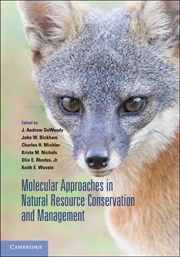Book contents
- Frontmatter
- Contents
- Contributors
- Preface
- 1 Biodiversity discovery and its importance to conservation
- 2 Gene flow, biodiversity, and genetically modified crops: Weedy rice in Thailand
- 3 A community and ecosystem genetics approach to conservation biology and management
- 4 Vertebrate sex-determining genes and their potential utility in conservation, with particular emphasis on fishes
- 5 Historical and contemporary dynamics of adaptive differentiation in European oaks
- 6 Association genetics, population genomics, and conservation: Revealing the genes underlying adaptation in natural populations of plants and animals
- 7 Hybridization in threatened and endangered animal taxa: Implications for conservation and management of biodiversity
- 8 Pollen and seed movement in disturbed tropical landscapes
- 9 Implications of landscape alteration for the conservation of genetic diversity of endangered species
- 10 Integrating evolutionary considerations into recovery planning for Pacific salmon
- 11 Using molecular methods to improve the genetic management of captive breeding programs for threatened species
- 12 Wildlife reintroductions: The conceptual development and application of theory
- 13 Evolutionary toxicology
- Index
- Plates
- References
11 - Using molecular methods to improve the genetic management of captive breeding programs for threatened species
Published online by Cambridge University Press: 05 July 2014
- Frontmatter
- Contents
- Contributors
- Preface
- 1 Biodiversity discovery and its importance to conservation
- 2 Gene flow, biodiversity, and genetically modified crops: Weedy rice in Thailand
- 3 A community and ecosystem genetics approach to conservation biology and management
- 4 Vertebrate sex-determining genes and their potential utility in conservation, with particular emphasis on fishes
- 5 Historical and contemporary dynamics of adaptive differentiation in European oaks
- 6 Association genetics, population genomics, and conservation: Revealing the genes underlying adaptation in natural populations of plants and animals
- 7 Hybridization in threatened and endangered animal taxa: Implications for conservation and management of biodiversity
- 8 Pollen and seed movement in disturbed tropical landscapes
- 9 Implications of landscape alteration for the conservation of genetic diversity of endangered species
- 10 Integrating evolutionary considerations into recovery planning for Pacific salmon
- 11 Using molecular methods to improve the genetic management of captive breeding programs for threatened species
- 12 Wildlife reintroductions: The conceptual development and application of theory
- 13 Evolutionary toxicology
- Index
- Plates
- References
Summary
Captive breeding programs are powerful tools for the conservation of our natural resources. Both animal and plant biodiversity are in global decline (International Union for Conservation of Nature [IUCN] 2008), and the trend is for levels and rates of endangerment to continue increasing (Butchart et al. 2005; see also Chapter 1 by Honeycutt and colleagues). When in-situ conservation efforts are insufficient at stopping or reversing the decline of a species, captive populations often represent the only alternative for forestalling extinction. For example, it is currently estimated that hundreds of amphibian species will soon be extinct if emergency measures are not taken to protect populations in captivity until the threats to wild populations can be halted or overcome (Gascon et al. 2007). The success of numerous captive breeding programs has been well documented. As just a few of many examples, captive breeding programs have saved the black-footed ferret (Mustela nigripes), Przewalski's horse (Equus caballus przewalskii), and the California condor (Gymnogyps californianus) from final extinction (after the last wild populations were extirpated) and new wild populations of the golden lion tamarin (Leontopithecus rosalia), Arabian oryx (Oryx leucoryx), and whooping crane (Grus americana) have been successfully re-established from captive stocks.
Conservation breeding programs aim to maintain populations that are representative of their wild counterparts, to provide a reservoir for future reintroductions and recovery efforts (see Chapter 12 by Rhodes and Latch). Thus, the genetic goals of captive population management are to minimize genetic drift, retain genetic diversity, restrict inbreeding, and limit adaptation to captivity (Lacy 1994). The foundations of most captive breeding programs are pedigree analyses, which are used to manage both the demography and genetics of captive populations (Ballou & Foose 1996).
Information
- Type
- Chapter
- Information
- Publisher: Cambridge University PressPrint publication year: 2010
References
Accessibility standard: Unknown
Why this information is here
This section outlines the accessibility features of this content - including support for screen readers, full keyboard navigation and high-contrast display options. This may not be relevant for you.Accessibility Information
- 26
- Cited by
